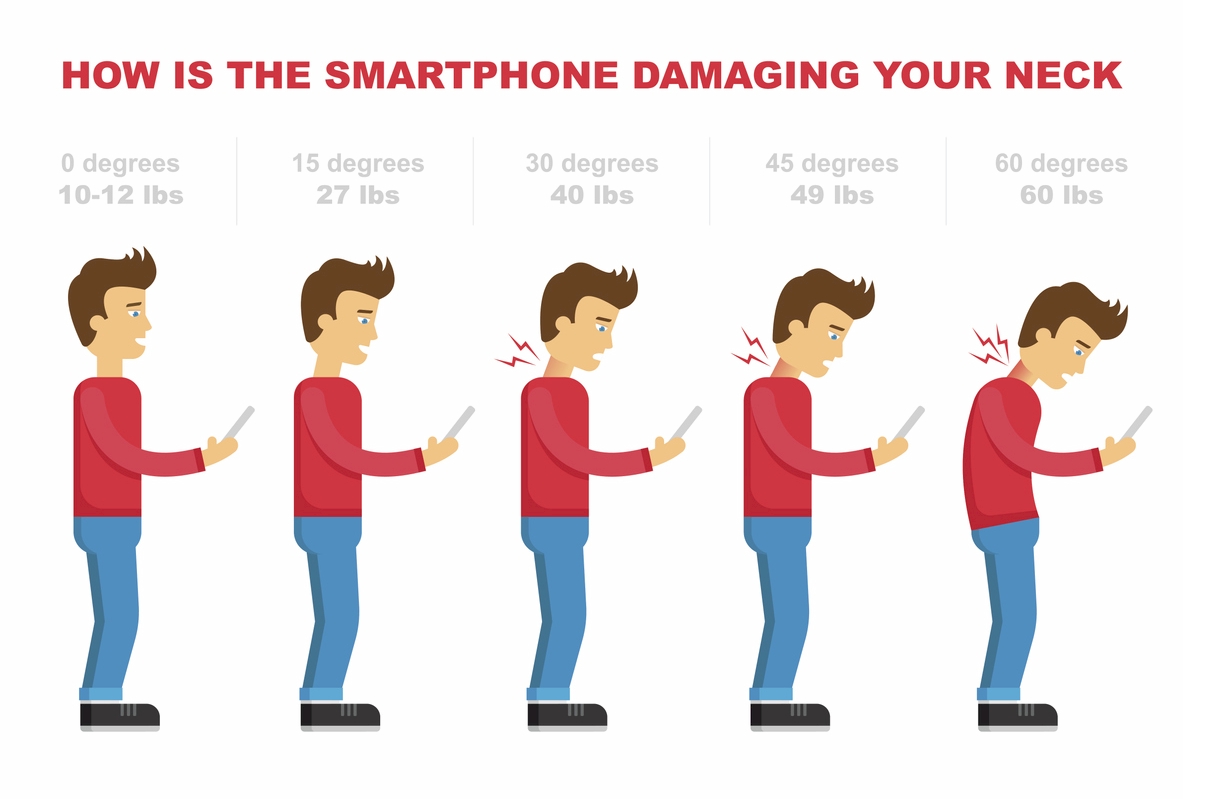The Good, Bad, and Ugly – Hand Held Device Use
Written by: Carolynn Kallitsis, Ergonomic Consultant
Are you reading this while bent over a table, head tilted forward and your shoulders rolled in? The position you are in is likely resulting in some discomfort. As technology changes, our posture and body mechanics should adapt as well.

The term “text neck” is used to describe repeated stress injuries and pain in the neck as a result of excessive use of hand held devices and has been seen to cause headaches, neck related pain, and shoulder discomfort. Research has shown that poor ergonomics and excessive use of hand held devices can contribute to overuse and posture related injuries. A recent article published by a New York Spine Surgeon, Kenneth K. Handraj, reported that as the head tilts and angles forward, muscles, tendons and ligaments surrounding the spine and the intervertebral discs are involved in helping to distribute the forces exerted on the neck. On average, a human head weighs 10 pounds in a neutral position. When tilted forward, the forces exerted on the neck increase. Handraj’s computer model found that 15 degrees of flexion can equate to a head weighing 27 pounds, 45 degrees of neck flexion equates to 49 pounds while 60 degrees of neck flexion equates to 60 pounds. This excess weight can cause wear and tear on the neck, spine and upper back. In addition, “text neck” has shown correlation to nerve pain and can progress into vascular disease and gastrointestinal complications according to Handraj’s research.
Eliminating “text neck” is up to you! You can consider some or all of the following recommendations:
- be self-aware and take frequent breaks;
- find an optimal viewing angle slightly below eye level;
- increase font settings to allow for eye comfort when viewing; &
- adjust screen resolution and brightness for comfort.
Other terms such as “texting thumbs” or “tech hand” have been coined to describe injuries caused by hand held device use. Giving up your hand-held device is the answer, but we both know that this is not realistic! The outcome, of excessive hand-held device use may result in wrist and forearm pain and weakness, achy hands, swelling and hindered function. These discomforts can be caused by excessive gripping, grasping or clenching. We have provided a list of ergonomic recommendations below to help eliminate these discomforts:
- limit the amount and lengths of text messages;
- ensure a hands-free option is available on your device and utilize apps available for voice recognition;
- change your grip posture to avoid excessive gripping on your device;
- understand the optimal operating ranges on your touch screen;
- ensure neutral wrist and upper extremity postures and alternate between thumb and finger typing; &
- take postural breaks and perform stretches as necessary.
Injuries relating to hand-held device use are on the rise and it is important to be mindful of ergonomics when using hand-held devices. As humans we are heavily influenced by technological advancements, let’s consider the power of being proactive and eliminate the bad and ugly of hand-held device use. If you are interested in learning more about the bad and the ugly of hand held device use please contact us at the link below.
Resources:
www.theatlantic.com/health/archive/2014/11/what-texting-does-to-the-spine/382890/www.cnn.com/2014/11/20/health/texting-spine-neck-study/index.html
www.theglobeandmail.com/life/article-how-do-i-manage-the-pain-of-texting-thumb/
www.elitecme.com/resource-center/rehabilitation-therapy/ergonomics-cell-phones-the-injuries-at-hand/
www.uclahealth.org/safety/Workfiles/Mobile-Phones-Tablets-Tips.pdf
Contact Us Back to Articles
